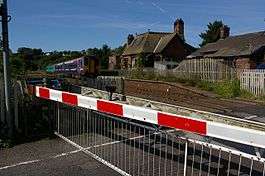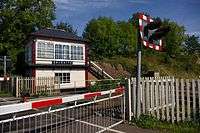Culgaith railway station
Culgaith railway station was a railway station which served the village of Culgaith in Cumbria, England.
| Culgaith railway station | |
|---|---|
 Culgaith station | |
| Location | |
| Place | England |
| Area | Eden |
| Coordinates | 54.656°N 2.606°W |
| Grid reference | NY60942918 |
| Operations | |
| Original company | Midland Railway |
| Post-grouping | London Midland and Scottish Railway |
| Platforms | 2 |
| History | |
| 1 April 1880 | Opened[1] |
| 4 May 1970 | Closed[1] |
| Disused railway stations in the United Kingdom | |
| Closed railway stations in Britain A B C D–F G H–J K–L M–O P–R S T–V W–Z | |
_geograph-3117548-by-Ben-Brooksbank.jpg)
History

The Settle-Carlisle Line is open however and the nearby level crossing and associated semaphore signalling are at present still operated through the Culgaith signal box. The station was built by the Midland Railway and opened in 1880. The station was designed by the Midland Railway company architect John Holloway Sanders.[2] It closed when local stopping trains over the Settle-Carlisle Line were withdrawn in May 1970.
The Settle-bound (up) station building (which sits on a surviving portion of the southbound platform) has been converted into a private dwelling. The nearby garden centre includes buildings that were once used to pack hampers for those heading north on the railway for pheasant shoots, deer stalking, etc. in Scotland. The station master's cottage has also survived, now in private hands.
The buildings possessed a completely different appearance to all other stations on the Settle - Carlisle line due to it being built four years after the others; it was designed by John Holloway Sanders and is of style known as Derby Gothic.[3] The Station Master had a small cottage originally meant for a crossing keeper, rather than the normal substantial house. The Midland Railway hadn't intended to build a station serving the village until the local vicar objected. A local stone was used.[4]
The signalbox is a Midland Railway type 4a design, built in 1908, and controls the first level crossing on the line heading northwards, the only other level crossing being at Low House, just north of Armathwaite. The 661 yd. Culgaith Tunnel lies nearby.[5]
A serious accident occurred just to the north of here in March 1930, when the 8.05am stopping passenger train from Hellifield to Carlisle collided with a stationary engineers train that was engaged in unloading ballast in Waste Bank Tunnel. The driver of the local train and one passenger died in the accident, whilst 8 people were injured. The subsequent inquiry report determined that the primary cause of the accident was the passenger train passing the station starting signal at danger and entering the occupied block section ahead; however the flagman (lookout) protecting the ballast train and the Culgaith signalman were also criticised for their actions prior to the accident[6] - the former for improperly removing detonators previously laid to protect the stationary train and the latter for failing to sufficiently check the passenger train at the home signal prior to it entering the station.
The Culgaith Parish plan calls for the re-opening of Culgaith station with an adequate provision for parking.
References
- Notes
- Quick 2009, p. 141.
- "Notes by the Way". Derbyshire Times and Chesterfield Herald. British Newspaper Archive. 1 November 1884. Retrieved 12 July 2016 – via British Newspaper Archive.
- Brief Encounters Cafe Archived 19 April 2013 at Archive.today Retrieved : 2012-09-04
- Culgaith Crossing Retrieved : 2012-09-03
- Culgaith Station Retrieved : 2012-09-03
- "Report on the Accident between Culgaith and Langwathby on 6th March 1930"The Railways Archive; Retrieved 2012-10-23
- Sources
Quick, Michael (2009) [2001]. Railway passenger stations in Great Britain: a chronology (4th ed.). Oxford: Railway and Canal Historical Society. ISBN 978-0-901461-57-5. OCLC 612226077.
| Preceding station | Historical railways | Following station | ||
|---|---|---|---|---|
| Langwathby | Midland Railway Settle-Carlisle Railway |
New Biggin | ||
| Wikimedia Commons has media related to Culgaith railway station. |